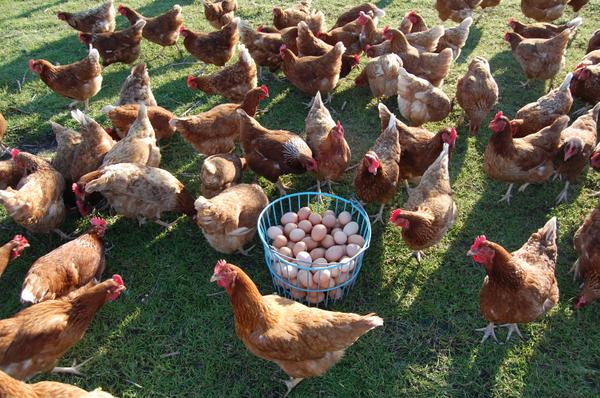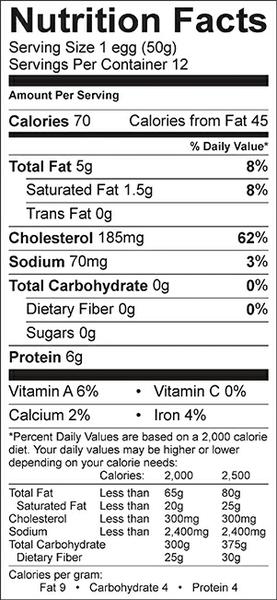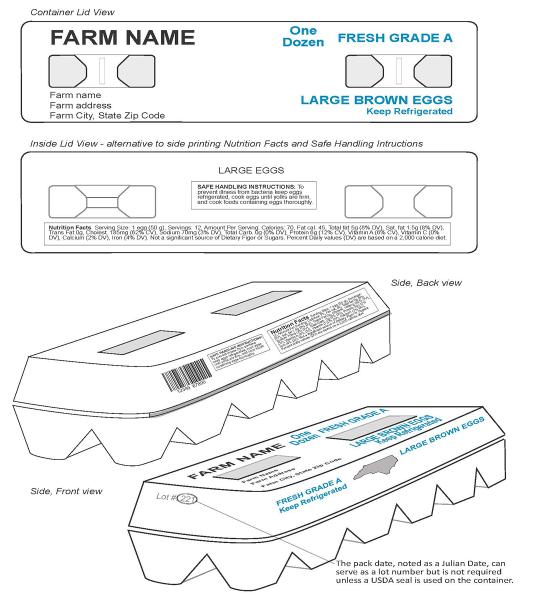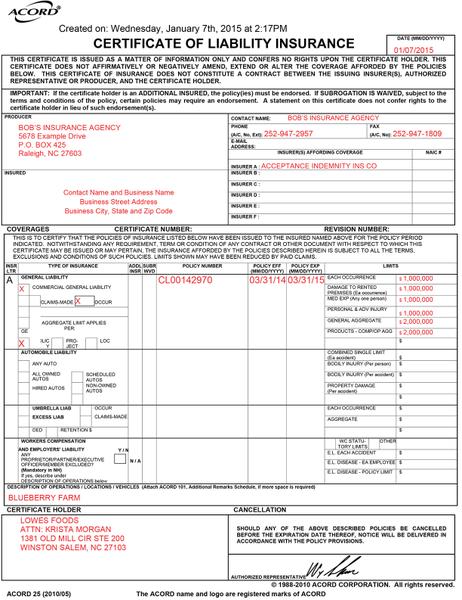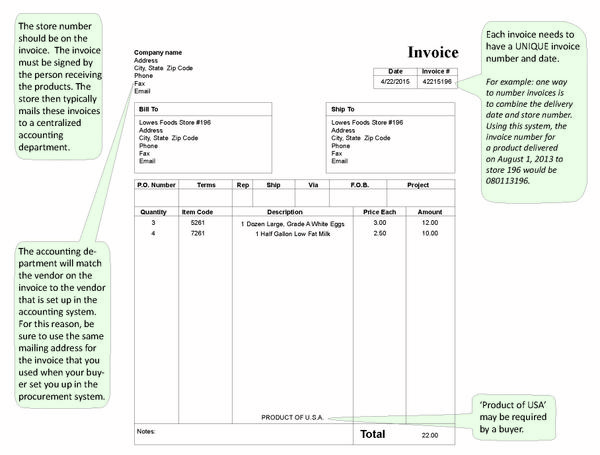Are you a small or medium-scale, North Carolina egg producer? Are you interested in expanding your markets into North Carolina grocery stores? This publication will help you get started marketing to grocery stores through direct store delivery (DSD).
Long lines at egg vendors’ stands at farmers markets, as well as the tendency for eggs to be the first product to sell out at farmers markets, attest to a strong demand for fresh eggs in North Carolina. In addition, the market value of all agricultural products (such as produce, eggs, poultry, and meat) sold directly to consumers in North Carolina rose nearly 10% between 2007 and 2012 and is expected to continue to increase (2012 USDA Ag Census). Retail outlets, such as grocery stores, provide an opportunity to meet consumer demand for locally produced eggs while potentially providing egg producers with a broader consumer base.
Introduction
This publication includes introductory information to help improve your potential to successfully and profitably sell eggs into retail channels. Be sure to communicate with your buyer to ensure you meet all of the retailer’s requirements.
Topics covered in this publication include:
- What you need to know before approaching a retailer
- The vendor setup process at the retailer
- Packaging and labeling for retail markets
- Preparing your first delivery to the retailer
This publication does not include any legally binding interpretations, and further questions or clarification requests should always be directed to the North Carolina Department of Agriculture & Consumer Services (NCDA&CS) Food & Drug Protection Division.
Assumptions
The information presented here assumes that you are already fully compliant with state and federal laws and regulations governing shell egg production, processing, and sales. Dr. Kenneth Anderson, an Extension specialist in the Prestage Department of Poultry Science at North Carolina State University’s College of Agriculture and Life Sciences, has developed the N.C. Cooperative Extension publication, Explaining the North Carolina Egg Law for Producers with Small Flocks, to help producers interpret the North Carolina Egg Law. You may wish to speak with an attorney for clarification on the laws pertaining to egg production. You can find web addresses for the Extension publication and other NC Egg Law resources in the Additional Resources section.
What You Need to Know Before Approaching a Retailer
Most retail grocers work with egg producers (and other producers of perishable direct-store-delivery products) on a “guarantee” basis. This means that you will need to pick up any out of date dozens and replace them with fresh ones.
Before you approach a retailer, be prepared to answer the following questions:
- What is the wholesale cost per dozen eggs?
Example answer: $X.XX per dozen. - Do you have a product price list? (This can include all of your products, not just eggs.)
Example answer: Yes. I have attached a product price list to this email (or, Yes, I can mail that to you). - How many stores are you interested in delivering to? In what area(s)?
Example answer: Ten stores in the Raleigh/Durham and surrounding areas. - When can you start making deliveries?
Example answer: May 4, 2015. - Do you have your nutrition, packaging, and labeling completed?
Example answer: Yes. We have all our nutrition labels and packaging completed and printed. - Do you have your own UPC code(s)?
Example answer: Yes. A sample is attached. - How many dozens/cases of eggs could you deliver? How often? Include seasonal estimates if quantities will vary by season.
Example answer: One case includes 30 dozens of eggs. I can deliver a total of 20 cases per week to start but can expand to 40 cases per week if needed. - Do you have liability insurance?
Example answer: Yes. Proof of liability insurance is attached to this email (or, Yes. I can mail that to you).
Making Initial Contact With the Retailer
Good communication from the first contact could influence a retailer’s decision to buy from you when choosing among multiple vendors. If your first contact with the retailer is by email, provide all the above critical information up front. You may need to do some research to identify the appropriate individual at the retailer to contact. These are two approaches to determine the retailer contact:
- Call the store location nearest you and ask the store manager for the email address for the person in charge of egg buying.
- Call the retailer’s home office and ask for the name and best mode of contact for the director in charge of eggs.
Example email to send to the retailer (be sure to use information specific to your situation):
Dear [retailer point of contact name here],
I would like to express my interest in selling our farm’s local North Carolina eggs to 10 of your stores in the Raleigh/Durham area via Direct Store Delivery (DSD). One case includes 30 dozens. I can deliver a total of 20 cases per week, and I can expand to 40 cases per week if needed. Each dozen is $X.XX wholesale, and I can start delivering the week of May 4, 2015. We have all of our labels, including nutrition and UPC codes/packaging, as well as liability insurance. I have attached our full product pricing list, example labels, and proof of insurance for your reference.
Thank you,
Farmer/Farm name
Address
Phone number
Email address
Website
Getting All the Pieces Together
Where can I find label/packaging requirements?
The North Carolina Egg Law delineates requirements for egg container labeling. The following interpretation of the labeling section of the Egg Law is an excerpt from the NC State publication, Explaining the North Carolina Egg Law for Producers with Small Flocks, AG-802 (Anderson 2015):
Container labels must include the following information:
- Applicable consumer grade and egg size or weight class
- What is in the carton—“Eggs” (these eggs must be from a chicken)
- Numerical count of the eggs in the container
- Name and address of packer/distributor
- Previous packer information must be obscured and/or relabeled on reused containers (otherwise, the carton is inappropriately labeled) [Although reuse of egg containers is commonplace in farmers markets and farm stands, grocery stores generally do not accept reused packaging.]
- “Fresh” means Grade A or better (AA). This means no bloods, meatspots, misshapen shells, or dirts would be permitted except as allowed by USDA grade standards.
Grade and size descriptions must be in boldface type at least 3/8 inch in height. The address of the packer/distributor must not exceed lettering of 3/8 inch in height.
A pack date is only required on an egg container if a USDA shield is used. Small producers typically do not use USDA shields due to the additional expense associated with their use. For more information on using the USDA shield, see Chapter X of the USDA Egg Grading Manual referenced in the Additional Resources section. Though not required, a pack date, usually stamped as a Julian Date, can serve as a lot number. Lot numbers can benefit a grower in the instance of a food safety recall by potentially limiting the number of eggs included in the recall.
Sell by and use by dates are also optional, unless a retail grocer requires them. Sell by dates are 30 days after pack date, including day of packing, and use by dates are 45 days after pack date, including day of packing.
Other container labeling requirements for selling eggs to retail grocers include a nutritional fact panel (Figure 1) and a UPC code.
The preferred location for the UPC code is on the long side of the container. This placement minimizes the risk of the container being turned upside down to scan, reducing the potential for damage to the eggs. Standard locations for the nutritional fact panel include the long side of the container and inside the container lid. See Figure 2 for labeling examples.
Where can I find nutritional information?
Nutrient values for small (38g), medium (44g), large (50g), extra-large (56g), and jumbo (63) eggs are available from the USDA National Nutrient Database for Standard Reference. This database does not offer standard nutritional fact panels that include the size of eggs, number of servings per container, and nutrient values.
You can acquire a nutritional label either through a database or by sending the product for a full nutritional analysis. Nutritional fact panels are available for purchase through NC State University’s Entrepreneur Initiative for Food (ei4f). Contact ei4f at foodbusiness@ncsu.edu.
A full nutritional analysis is required if you are planning to make nutritional claims (e.g., Omega-3 enriched). Full analysis can be costly. The following list provides examples of labs that can run a full analysis:
Note: This list is not meant to be exhaustive. The inclusion or exclusion of names on this list is not meant to imply endorsement.
Copying nutritional panels from other company egg containers is not recommended because you will be liable for anything that may be incorrect.
What about production claims?
Egg producers may wish to convey certain production methods to consumers to distinguish or add value to their product (e.g., free-range, organic, or pastured). Some claims require certification while others do not. In-depth review of these claims is outside the scope of this publication. You can find more information on these claims through the North Carolina Administrative Code 02 NCAC 43H .0101, Marketing of Shell Eggs. If you have further questions about using these claims, contact the NCDA&CS Egg Program’s food regulatory specialist. See the Additional Resources section for additional information.
Where do I purchase a UPC code?
A Universal Product Code (UPC) is a 12-digit international standard bar code that has many uses for retailers. Retailers can use UPCs to scan items through their cash registers, identify products, track sales, and manage product inventory. By connecting your product’s UPC to their inventory systems, retailers can track quantity on hand.
UPCs can be unique to your item and company, or they can be generic codes for standard commodity-type items. You can obtain unique UPCs either through a reseller or by joining the GS1 system, an international not-for-profit association that assures globally recognized bar codes.
Membership in the GS1 system costs about $250 for up to 10 items needing bar codes or $750 for up to 100 items. Membership must be renewed annually for a fee of $50 (1–10 items) or $150 (1–100 items). There is also a cost associated with printing the code(s).
UPC resellers are much less expensive because there is no membership fee, and the cost is about $7 for one UPC. Use caution, however, as some major retailers will not accept resold UPCs because the third party seller may not be able to guarantee that prefixes are unique.
Before speaking with your buyer, learn more about GS1 versus UPC resellers by viewing the NC Department of Agriculture & Consumer Services’ Got To Be NC video, “Do I need a UPC Code?”
Additional information on UPCs, including where to order UPC labels, can be found in the North Carolina Growing Together and NC Cooperative Extension publication, Tips for Produce Growers Marketing Fresh Produce to Retail Grocers: Understanding PLU and UPC Codes, LF-002 (Fugate 2014).
What liability insurance do I need?
Retail grocery stores have specific requirements for liability insurance, and grocery buyers will require that you present proof of insurance before they purchase your eggs. Figure 3 is an example of acceptable proof of insurance.
How do I invoice?
The North Carolina Egg Law describes invoice requirements for any person marketing eggs to a retailer. Explaining the North Carolina Egg Law for Producers with Small Flocks, AG-802 (Anderson 2015) interprets invoice requirements of the Egg Law as follows:
Invoice Requirements:
- Any person marketing eggs to a retailer, institution or other person must provide an invoice with the following information:
- Date of sale
- Name and address of seller
- Name of purchaser
- Quantity
- Grade
- Size/weight classification
- Sellers and buyers should maintain invoices on file for 30 days.
- An exemption exists for a producer selling to another for candling and grading only.
- Eggs eligible for sale without grading should be labeled “Ungraded Eggs.”
Preparing for Your First Successful Delivery
Once you and the buyer have agreed on the store location(s), discuss with the buyer the best way for you to make contact with the retailer or store manager(s) directly. This may include a store visit prior to your first delivery date, an email, or a phone call. Be sure to wait for permission from the buyer before you make any direct contact with a store.
During the first communication with your store contact, confirm delivery details. Discuss preferred delivery days and times, who the receiver is for that particular store, the delivery location (i.e., back door or front door), the restocking location, the reorder process, what to do if you are late, sell by/use by date requirements, and any other questions you may have. This is also a good time to discuss placing your eggs in a favorable location in the egg display. Individual stores vary in their flexibility for placement. Request a placement among the specialty egg products, such as with brown eggs and eggs with nutritional claims. Also, explore opportunities to work with the store contact on point-of-sale materials that tell your product’s story. This conversation is your opportunity to start a relationship with each store, make a vital first impression for marketing your product and gaining reorders, and delineate a merchandising plan to increase your potential for successful and profitable sales.
"The most important thing is to be flexible and fleet on your feet. When dealing with a big retailer, you might have to do things to fit the needs of [an organization] that is a lot bigger than you are."
Garland McCollum, Massey Creek Farms
North Carolina pastured egg producer.
This part of the process will vary depending on the retailer, so it is important to communicate clearly with your buyer and your store contact. Be sure you leave the first meeting with a full understanding of the store requirements, how the store handles deliveries, and whether or not your sales will be based on a guarantee.
After the First Delivery
Remember that your first successful delivery is just the beginning of your relationship with a store. To maximize your profits, it will be important for you to keep up with how well your eggs are selling at each store and adjust the amount delivered to reduce product losses. Be aware that sales may fluctuate over time, so if the store runs out of eggs before your next planned delivery, you may have an opportunity to make an extra delivery.
"Once [customers] buy your product and are happy with it, they will come back.”
Christy Crumpler, Brittany Ridge Farms
North Carolina pastured egg producer.
Look for opportunities to help the store market your products. For example, some stores offer in-store tastings. You are the expert, and store guests love meeting and hearing about the farms that produce their food. Education can result in higher sales and repeat purchases. You can discuss these types of opportunities during your initial meeting and perhaps find a date soon after your first delivery for your farm to participate in a store event.
Additional Resources
North Carolina Egg Laws and Legal Resources
Anderson, Kenneth. 2015. Explaining the North Carolina Egg Law for Producers with Small Flocks. AG-802. Raleigh, NC: NC Cooperative Extension Service.
North Carolina Bar Association Referral Service.
North Carolina Egg Law. North Carolina Gen. Stat. Chapter 106, Article 25A § 106 245.13–§ 106 245.29.
North Carolina Department of Agriculture & Consumer Services. 2011. Egg Law Presentation.
Nowlin, Michelle B. 2012. Growing your Local Food Business in North Carolina: A Guide to Laws and Regulations. Carolina Farm Stewardship Association. pp. 14–16. .
Other Useful resources for Small Egg Producers
Current Good Manufacturing Practices. Food and Drug Administration (FDA) Regulations. 21 CFR § 110.
Egg Promotion Tax. North Carolina Gen. Stat. Chapter 106, Article 25B § 106-245.30–§ 106-245.38.
Fugate, Ariel. 2014. Tips for Marketing Fresh Produce to Retail Grocers: Understanding PLU and UPC Codes. LF-002. Raleigh, NC: The Center for Environmental Farming Systems and N.C. Cooperative Extension Service.
Marketing of Shell Eggs. 1998. North Carolina Adm. Code. 02 NCAC 43H .0101.
Minimum Net Weight for Various Egg Containers. 1999. NC Department of Agriculture & Consumer Services. Accessed July 2015.
USDA Egg-Grading Manual. 2000. Agricultural Handbook Number 75.
USDA National Nutrient Database for Standard Reference. National Agricultural Library.
For additional information, including clarifications on the North Carolina Egg Law, training opportunities, or marketing assistance, contact:
|
Bill Bruton |
Ken Anderson |
For marketing guidance, contact the Marketing Division at the North Carolina Department of Agriculture & Consumer Services.
Acknowledgements
The authors extend their appreciation to Ken Anderson, Gary Beiland, Bill Bruton, Rebecca Dunning, and Tristan Laundon for their useful insights and/or review of this publication.
This material is based upon work that is supported by the National Institute of Food and Agriculture, U.S. Department of Agriculture, under award number 2013-68004-20363. Any opinions, findings, conclusions, or recommendations expressed in this publication are those of the author(s) and do not necessarily reflect the view of the U.S. Department of Agriculture.
CEFS is a partnership of North Carolina State University (NC State), North Carolina Agricultural & Technical State University (NC A&T), and the North Carolina Department of Agriculture & Consumer Services (NCDA&CS).
More information:
Center for Environmental Farming Systems
North Carolina Growing Together
Publication date: Sept. 9, 2015
LF-006
The use of brand names in this publication does not imply endorsement by NC State University or N.C. A&T State University of the products or services named nor discrimination against similar products or services not mentioned.
N.C. Cooperative Extension prohibits discrimination and harassment regardless of age, color, disability, family and marital status, gender identity, national origin, political beliefs, race, religion, sex (including pregnancy), sexual orientation and veteran status.

